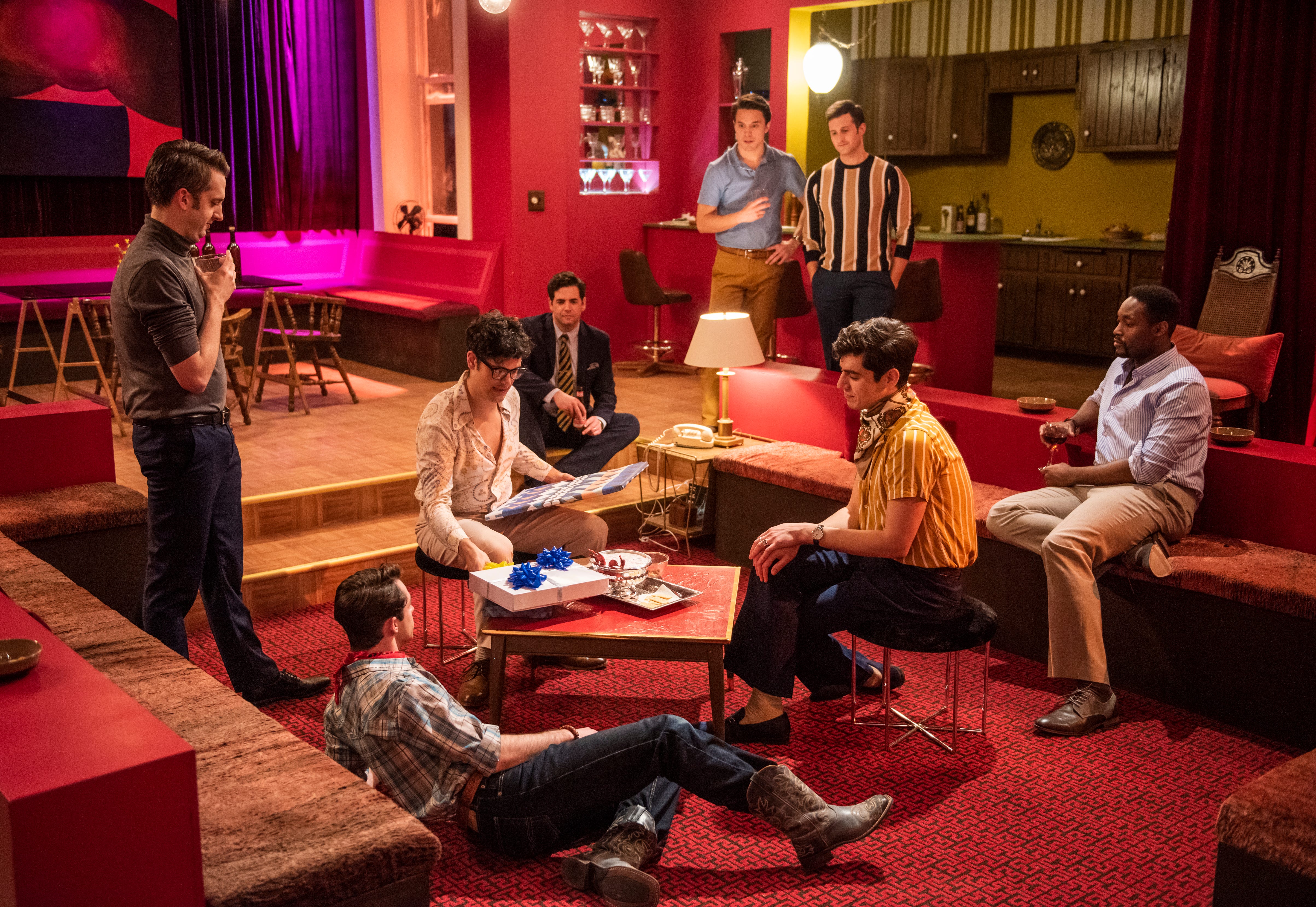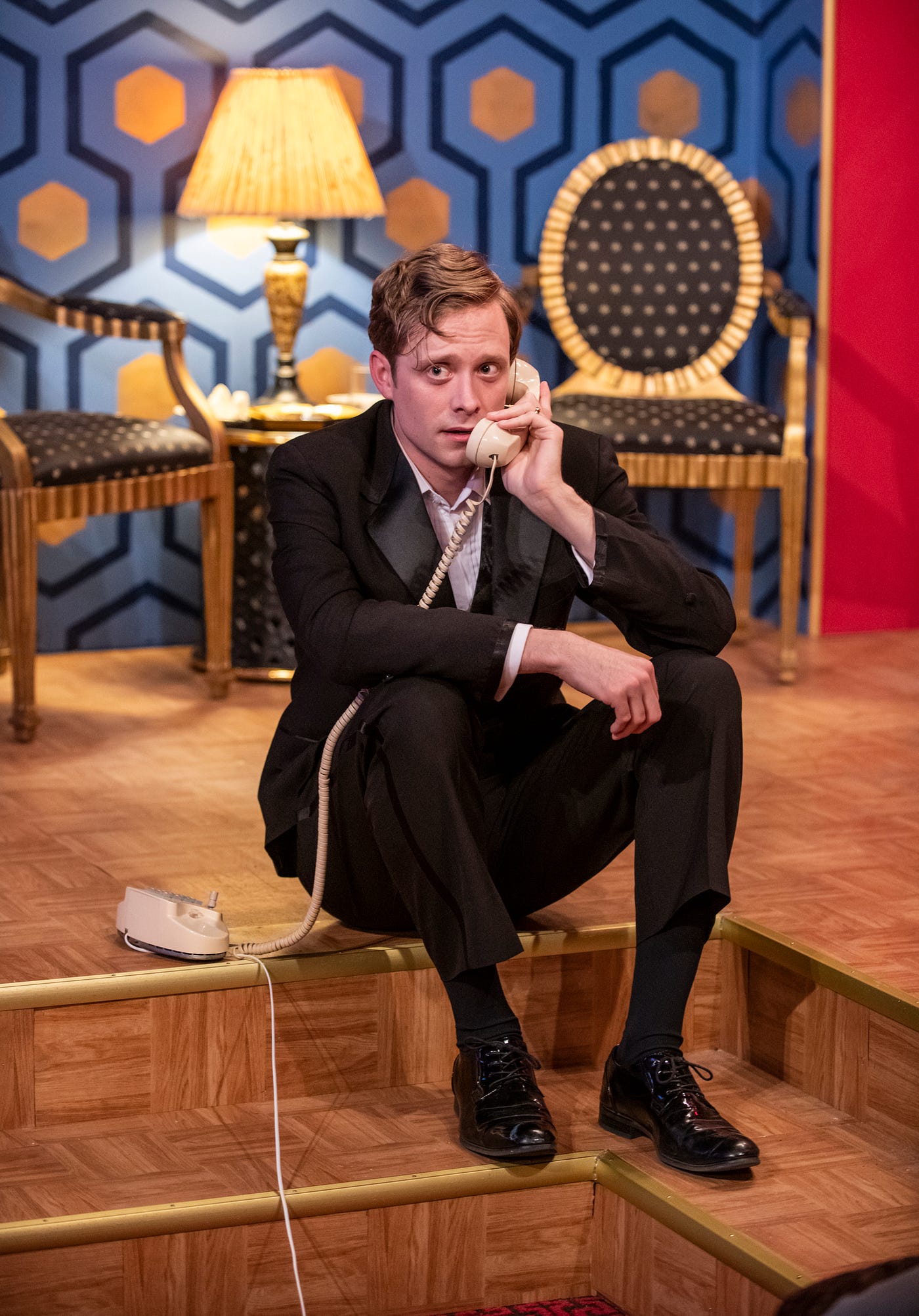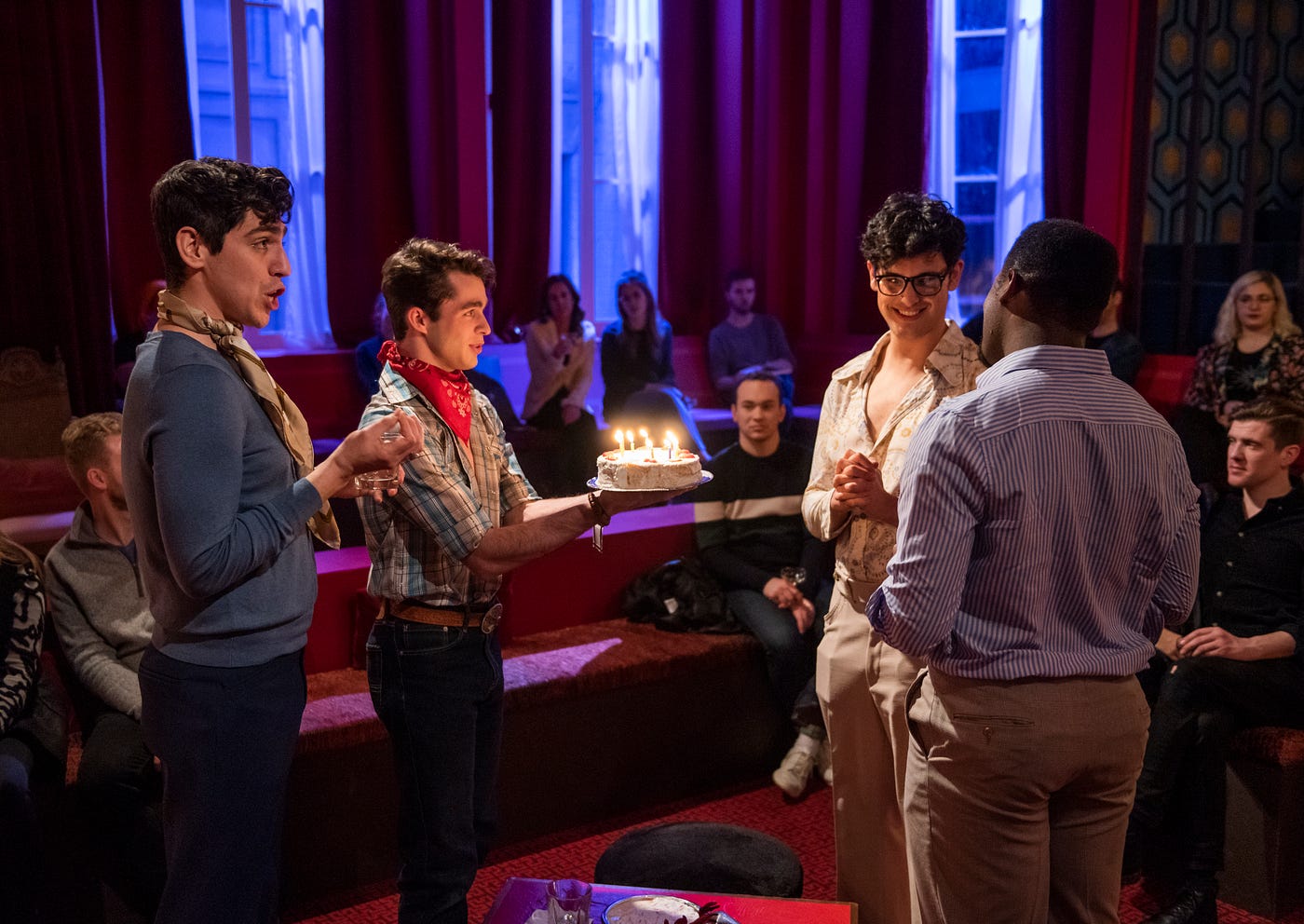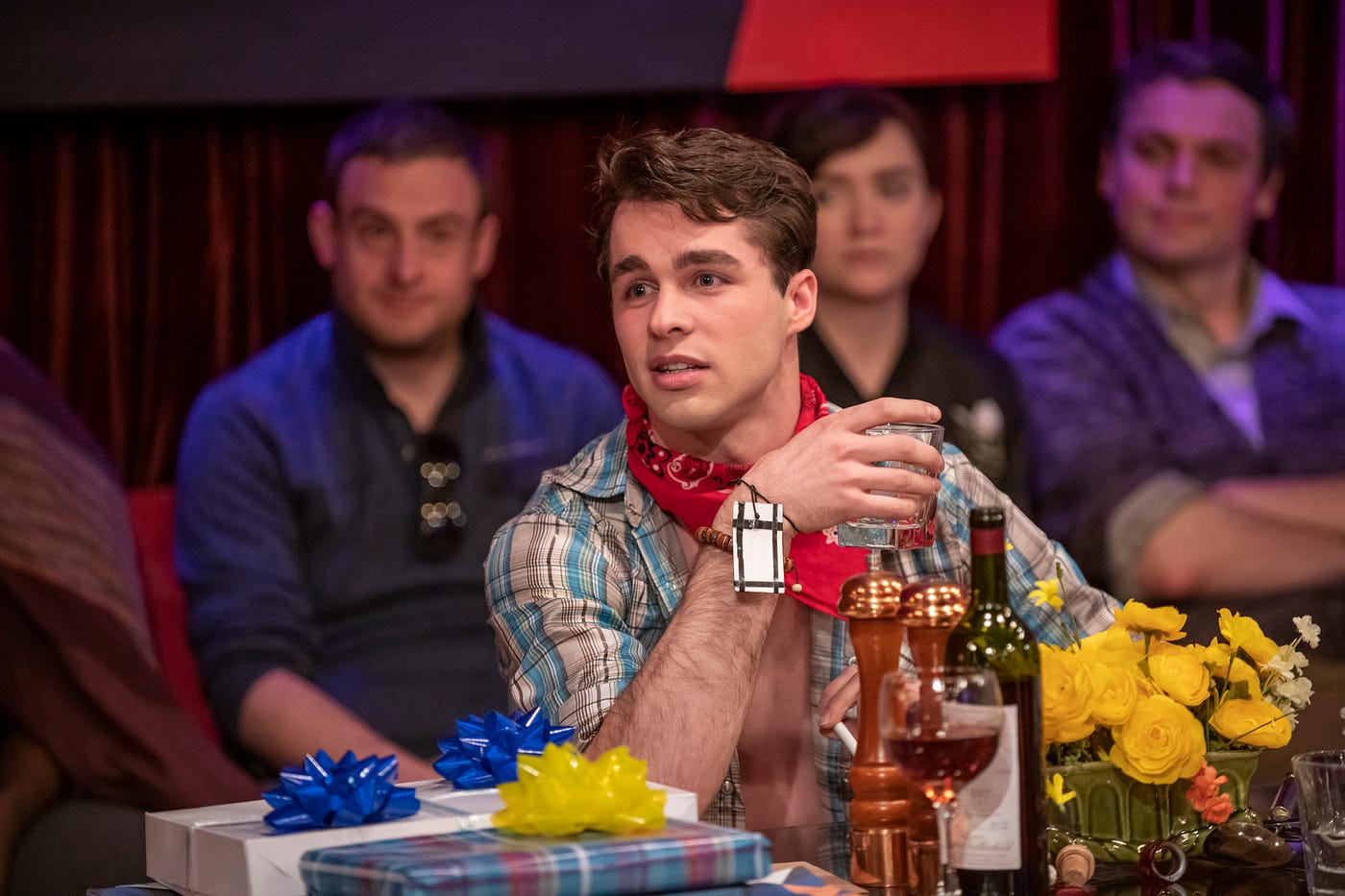Partying With ‘The Boys In The Band’ (Review)
Windy City Playhouse remounts the classic play as an environmental experience


Planning birthday parties for someone else always seems to be a nightmare, a thankless burden for the organizer. When you’re young, it’s all about quantity, the more people in attendance providing self-validation through popularity. As you get older, you cultivate a selective group of friends, weeding out anyone you’d prefer not be in your life. But when serving as a party planner for someone else’s celebration, you’re often forced to invite the honoree’s friends, which always seems to include people you initially culled from your friend group or other folks you’d rather not socialize with. Dealing with these “frenemies” doesn’t get easier as you might just find yourself in a volatile situation, one where there’s fuel that’s just waiting to be lit up by the match of someone’s offhand, snide comment. It’s this exact kind of explosion that Matt Crowley’s classic play The Boys In the Band, remounted by Windy City Playhouse as an environmental experience, tells about a group of gay men in the 1960s.
It’s a classic Chicago winter day with endless gray skies. Everything seems covered in a thick snow that turns to slush when hitting the ground. After shrugging off my coat and warming myself by the fireplace in Windy City’s lobby, I check in to receive a written invite from Michael (Jackson Evans), requesting my presence at his Upper East Side apartment to celebrate “our” friend Harold’s (Sam Bell Gurwitz) birthday. It provides me all the details I need for the experience, including not letting my hunger get the best of me and to eat any prop food I see.
When a small group of the audience is ready, the Front-of-House staff informs us it’s time to use the “elevator” to reach Michael’s apartment. My small group turns a corner, leaving behind Windy City’s warm lobby, and are transported to a New York City walk-up building’s cramped, marble-titled lobby. The packages and letters sitting unattended in the lobby seem to subtly suggest a “simpler” time when your mail wouldn’t get stolen. The elevator doors open, operated by a man in a formal red bellhop’s uniform. As we go “up,” mechanical sound effects create a sense of movement. The elevator operator reads his book, paying us little attention. When we arrive, the operator opens a set of doors opposite to those we entered through, opening into a stereotypically claustrophobic apartment hallway. Before the play has even begun, Windy City Playhouse has effectively put me into “1968” thanks to their pre-show production design.
We enter through an ajar door at the end of the long hallway, my group of audience members find ourselves in Michael’s massive, loft-style apartment. The apartment is a total 180-degree turn from the hallway’s aesthetic. This is a penthouse suite belonging to a one percent New Yorker rather than the reasonable, one-bedroom apartment of a white-collar worker. But this huge apartment feels epic, a place where grand drama is destined to occur. Its open, square-shaped space is set up as a living room with a dining room table placed off to one side. Additionally, once the 40-person audience is settled in their seats, which come in the form of oversized red-painted benches scattered throughout the living room, the apartment’s vastness almost disappears. It becomes merely an intimate space set for a party among friends.

As the audience has been filing in, Michael’s been sitting at the dining room table, wrapping his present for Harold. Sadly, I arrived too late to see what the present is, or, rather, how the gift has been handled in Windy City’s remount, as Michael finishes wrapping it. Once Michael is done wrapping and the audience is fully seated, his weekend-only visiting partner Donald (Jordan Dell Harris) comes into the apartment. Then, the play begins as scripted. While the play is dated in its pacing and its — then cutting-edge — portrayal of gay men for the general public, the characters’ personal struggles in The Boys In The Band remain as vibrant and moving as ever. There’s a couple of younger women in the audience who are caught up in every revelation that unfolds in the play, unable to prevent their shock from being verbally expressed. (It’s a humble reminder that while I might know the classics inside-out, they can still be brand new to someone else.)
Get Patrick B. McLean’s stories in your inbox
Join Medium for free to get updates from this writer.
SubscribeSubscribe
Windy City’s production of The Boys In The Band is a return to form with their “moving” proscenium environmental staging of traditional plays, first used in their adaptation of Southern Gothic years prior. While being far from “a play you play,” they masterfully pull the audience into the play’s time and setting, letting the story and action unfold around the audience, with more dynamic results than on a proscenium stage. Even without any direct addressing of the audience, the weight of the dramatic tension building throughout The Boys in the Band is incredibly palpable. By being cast in the role of a silent and unseen voyeur, I’m able to be in the thick of it when the characters start arguing, casually and easily engaging in the emotional highs of the play, thanks to the safety of being uninvolved from any personal dramatic consequence.

Windy City Playhouse makes a promise that the audience should be able to move around during The Boys In The Band; in practice, it feels essentially impossible to do so. In a sold-out show, there’s only a few free inches between each person on the red benches. It felt unwelcome to get up. Also, if I did get up, I feared I’d have no place to go, especially with no one else moving. Standing didn’t feel like an option, either, as some parts of the living room are narrow in size, with barely enough room for the actors to move through the apartment without an audience member there to mess up their blocking. The Boys in The Band feels constricted compared to Southern Gothic, where the audience was able to move, quickly finding tiny pockets of space to adjust their “personal” proscenium. And in Southern Gothic, the empty wall space was a welcome place to quickly plant yourself to avoid any action, but the red benches set against the walls in The Boys In The Band prevent that from being an option in Michael’s apartment.
Additionally, there are the odd staging choices in The Boys In The Band that require the actors to climb on or sit on the audience’s red benches, physically pressing up against audience members without acknowledging them. Perhaps this could be read as an attempt to get audience members to get up and move around. While it’s always refreshing to have actors be among the audience, pulling them deeper into the environment of the play, it’s odd to go above and beyond to define an “audience-only” space and then use that space without considering the audience usage of said space.
Despite the awkwardness of asking the audience to move around without providing enough space to do so, Windy City Playhouse’s environmental take on traditional plays breathes new life into The Boys In The Band. As someone intimately familiar with the plot, the play’s story holds no surprises for me. But being right there “on stage” celebrating Harold’s birthday among friends deepens the impact each emotional blow The Boys In The Band dishes out.

The Boys In The Band continues in Chicago through April 19. Tickets are $75— 95.
NoPro is a labor of love made possible by our generous Patreon backers. Join them today!
In addition to the No Proscenium web site, our podcast, and our newsletters, you can find NoPro on Twitter, Facebook, YouTube, Instagram, in the Facebook community Everything Immersive, and on our Slack forum.
Office facilities provided by Thymele Arts, in Los Angeles, CA.